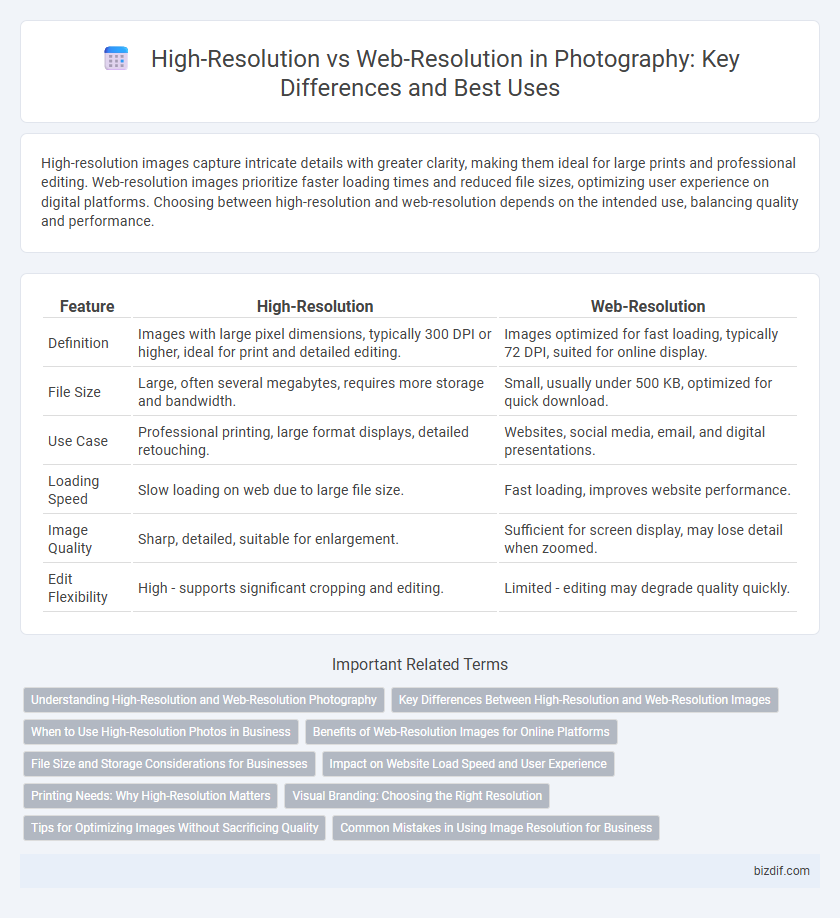High-resolution images capture intricate details with greater clarity, making them ideal for large prints and professional editing. Web-resolution images prioritize faster loading times and reduced file sizes, optimizing user experience on digital platforms. Choosing between high-resolution and web-resolution depends on the intended use, balancing quality and performance.
Table of Comparison
| Feature | High-Resolution | Web-Resolution |
|---|---|---|
| Definition | Images with large pixel dimensions, typically 300 DPI or higher, ideal for print and detailed editing. | Images optimized for fast loading, typically 72 DPI, suited for online display. |
| File Size | Large, often several megabytes, requires more storage and bandwidth. | Small, usually under 500 KB, optimized for quick download. |
| Use Case | Professional printing, large format displays, detailed retouching. | Websites, social media, email, and digital presentations. |
| Loading Speed | Slow loading on web due to large file size. | Fast loading, improves website performance. |
| Image Quality | Sharp, detailed, suitable for enlargement. | Sufficient for screen display, may lose detail when zoomed. |
| Edit Flexibility | High - supports significant cropping and editing. | Limited - editing may degrade quality quickly. |
Understanding High-Resolution and Web-Resolution Photography
High-resolution photography captures images with a greater number of pixels, resulting in finer detail and clarity ideal for large prints and professional editing. Web-resolution images use fewer pixels to ensure faster loading times and reduced file sizes, optimizing performance for online use. Understanding the difference is crucial for photographers to choose the appropriate resolution based on the intended medium and purpose.
Key Differences Between High-Resolution and Web-Resolution Images
High-resolution images typically have a pixel density of 300 DPI or higher, offering exceptional detail suitable for print media and large-format displays. Web-resolution images usually range from 72 to 96 DPI, optimized for faster loading times and efficient display on digital screens without excessive file size. Key differences include the image quality, file size, and intended use, with high-resolution favoring clarity and print compatibility, while web-resolution prioritizes speed and responsiveness on online platforms.
When to Use High-Resolution Photos in Business
High-resolution photos are essential in business contexts requiring detailed and sharp images, such as print marketing materials, product catalogs, and professional portfolios where clarity impacts brand perception. Using high-resolution images ensures optimal quality for large formats and close-up viewing, preventing pixelation and maintaining color accuracy. For web use, however, balancing resolution with file size is critical to optimize loading times without sacrificing visual appeal.
Benefits of Web-Resolution Images for Online Platforms
Web-resolution images optimize loading speeds on online platforms by reducing file sizes without sacrificing perceptible quality, enhancing user experience and engagement. These images are tailored to fit screen displays, ensuring faster rendering and minimizing bandwidth usage, which is crucial for mobile users and SEO performance. By striking a balance between clarity and file weight, web-resolution images support efficient content delivery across e-commerce sites, social media, and blogs.
File Size and Storage Considerations for Businesses
High-resolution images typically have larger file sizes ranging from 5MB to over 20MB, which significantly impacts storage requirements and increases costs for businesses managing extensive photo libraries. Web-resolution images, often compressed to under 500KB, optimize bandwidth usage and faster loading times on websites, reducing server load and storage expenses. Selecting the appropriate resolution balances image quality with practical file size constraints, ensuring efficient resource use without compromising visual appeal.
Impact on Website Load Speed and User Experience
High-resolution images contain more pixels and detail, significantly increasing file size, which can slow website load speed and negatively impact user experience by causing longer wait times. Web-resolution images are optimized for faster loading with smaller file sizes, balancing image clarity and performance to ensure smooth browsing across devices. Choosing the appropriate resolution affects SEO rankings, bounce rates, and overall engagement by influencing how quickly and effectively content displays.
Printing Needs: Why High-Resolution Matters
High-resolution images, typically 300 DPI or higher, are essential for printing to ensure sharp details and vibrant colors, preventing pixelation and blurriness. Web-resolution images, usually 72 DPI, are optimized for faster loading times but lack the detail required for quality prints. Choosing high-resolution photography is crucial for professional prints, large-format posters, and fine art reproductions where clarity and precision are paramount.
Visual Branding: Choosing the Right Resolution
High-resolution images, typically 300 DPI or higher, are essential for print materials to ensure sharp, professional visuals that reinforce brand quality. Web-resolution images, usually 72 DPI, optimize fast loading speeds and responsive display on screens without compromising essential visual details. Selecting the appropriate resolution balances image clarity and loading efficiency, directly impacting user experience and brand perception across digital and print platforms.
Tips for Optimizing Images Without Sacrificing Quality
High-resolution images contain more pixels and detail, ideal for print and professional photography, while web-resolution images are optimized for faster loading and compatibility with digital platforms. To optimize images without sacrificing quality, use lossless compression tools like PNG or WebP formats, and resize images to the exact dimensions required on the webpage. Employ techniques such as adjusting DPI to 72 for web use and applying smart cropping to preserve critical composition elements while minimizing file size.
Common Mistakes in Using Image Resolution for Business
Using high-resolution images on websites can slow page loading times, negatively impacting user experience and SEO rankings. Conversely, applying web-resolution images in print materials causes pixelation and reduces professional appearance. Businesses often confuse DPI (dots per inch) with PPI (pixels per inch), leading to improper resolution choices that compromise visual quality across different platforms.
High-Resolution vs Web-Resolution Infographic

 bizdif.com
bizdif.com